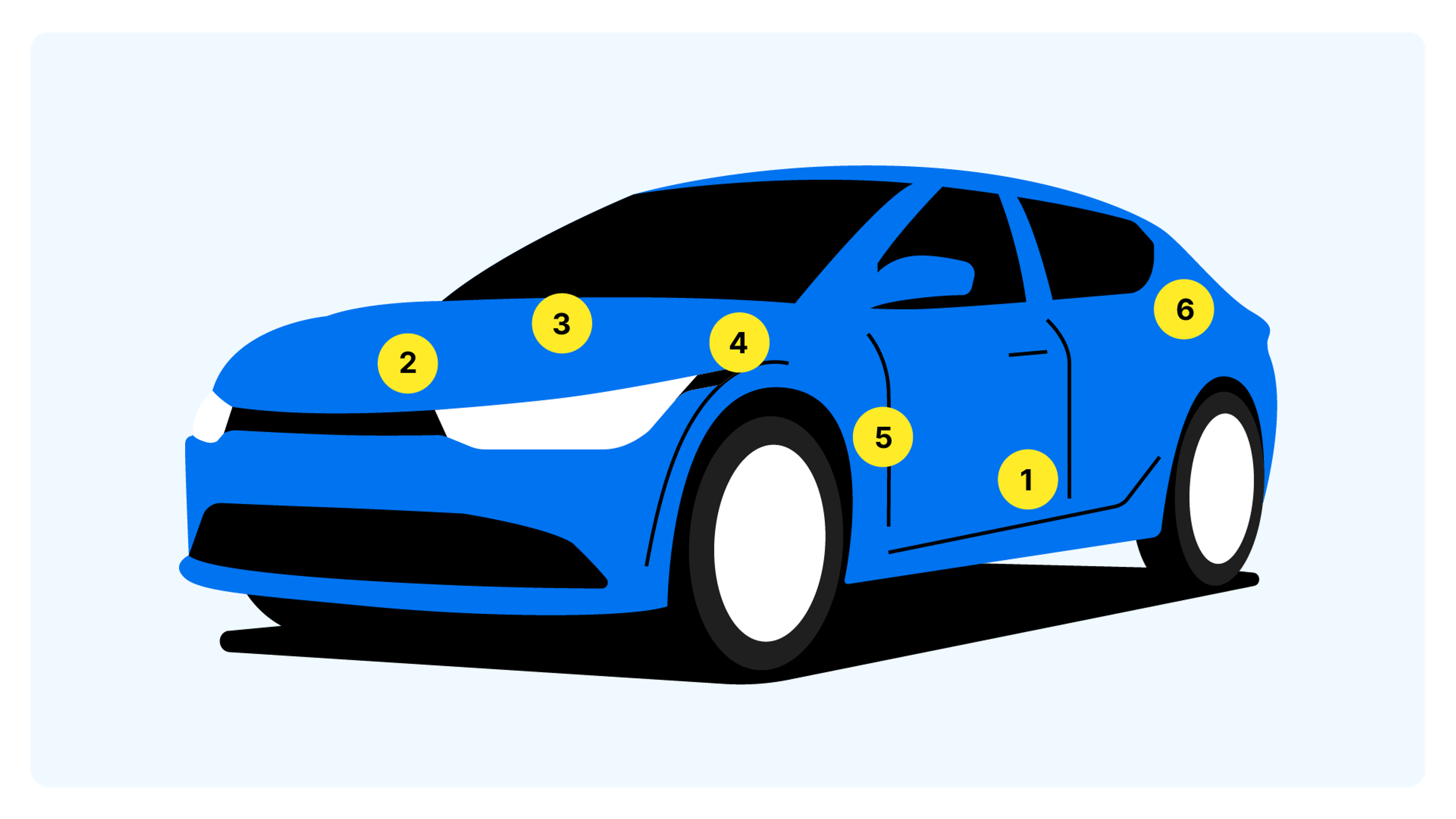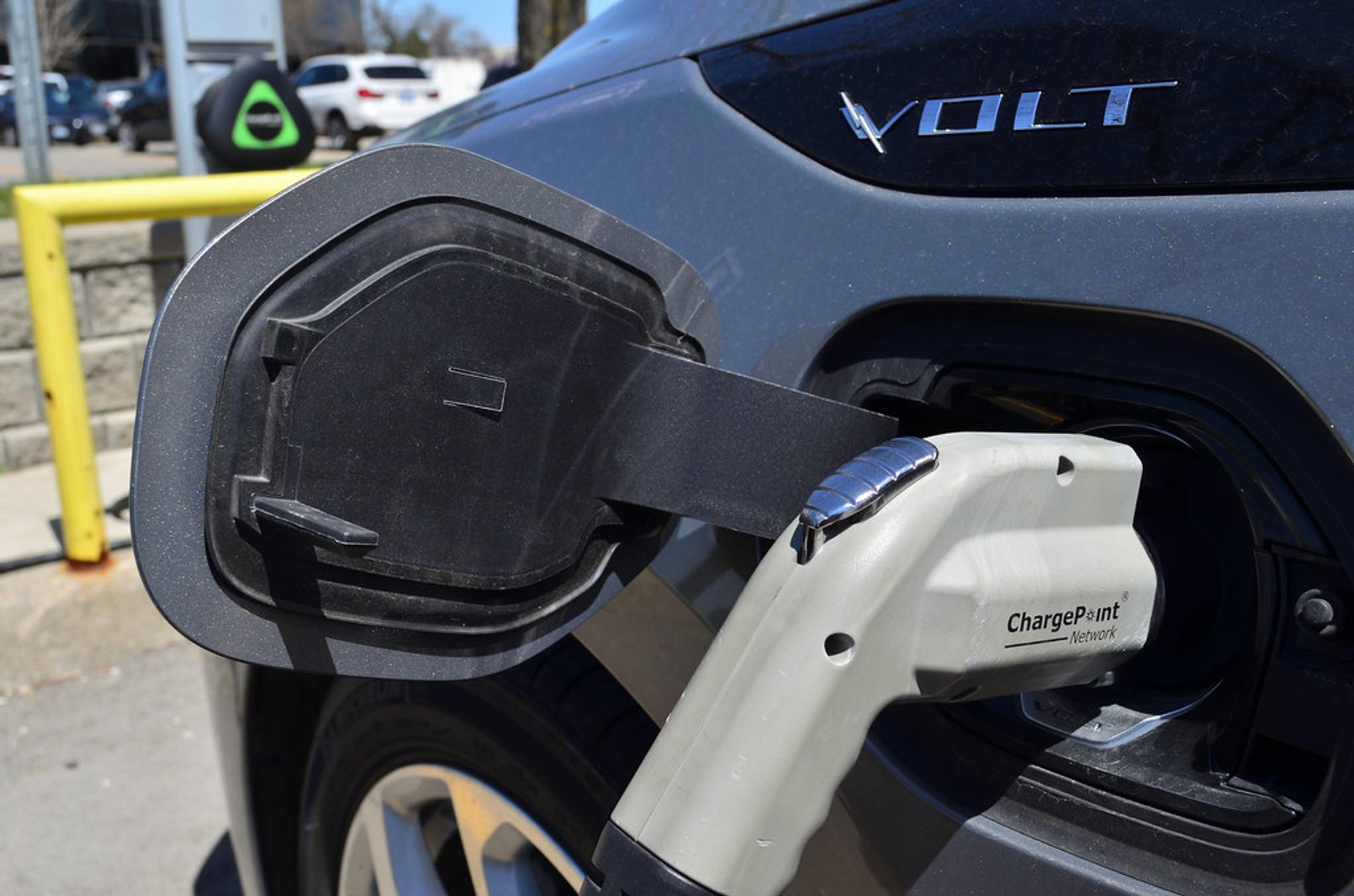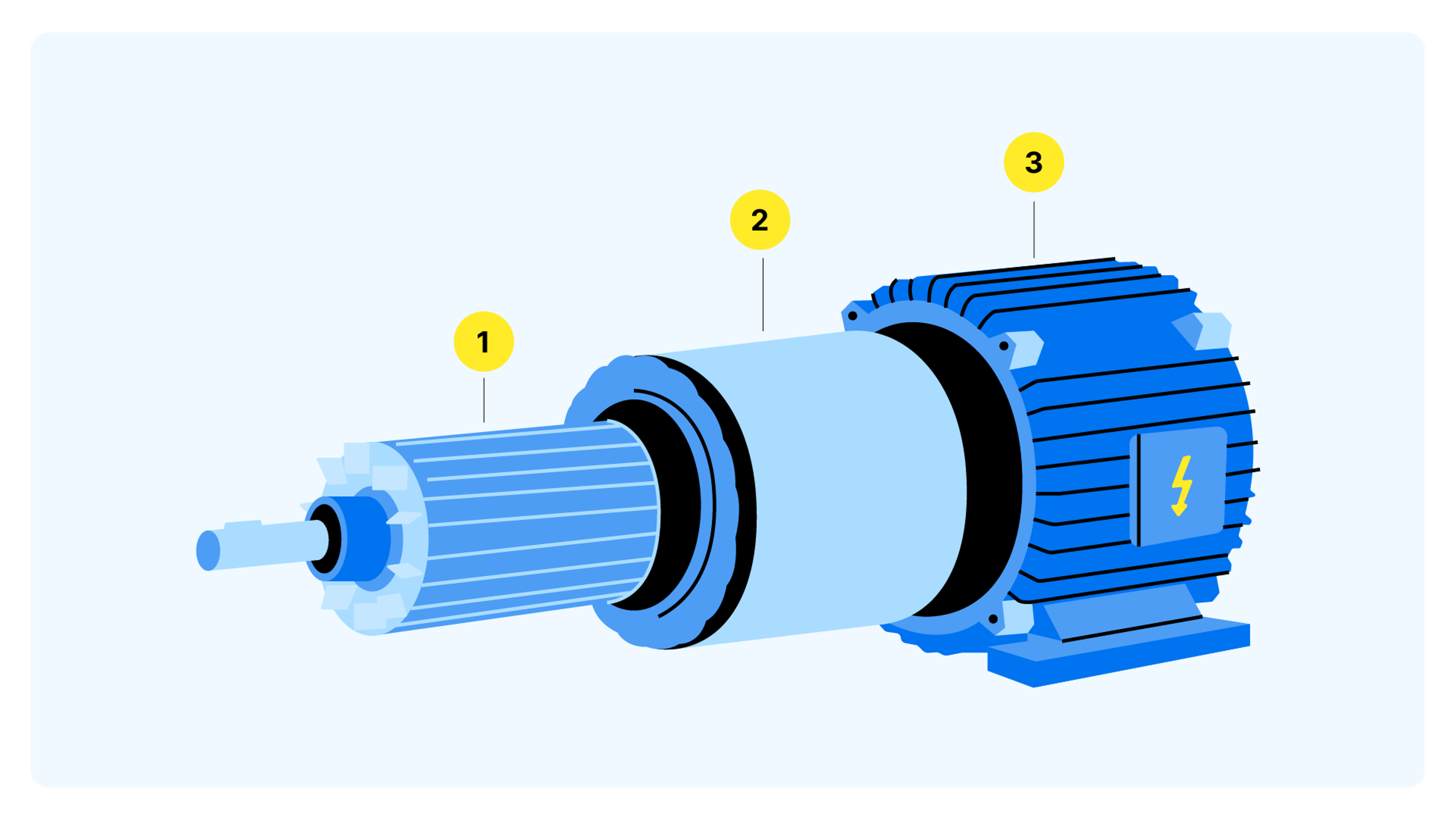How does an electric car work?

Evaldas Zabitis

Shiny electric cars charging on our driveways are becoming common as the world shifts towards a more sustainable future. More and more people choose all-electric vehicles (EVs) instead of gasoline or diesel cars, changing the automotive industry and the used vehicle market.
But how does an electric car work, and what should owners and potential buyers know about them?
Let’s dive into the inner workings of electric vehicles, exploring the technology behind them and the ways in which they differ from their gas-guzzling counterparts.

Used cars have dark secrets
Reveal them all! Just enter a VIN code and click the button:
What are the key parts of an EV?
Even though the powertrain of an electric car has about 10 times fewer moving parts compared to gas or hybrid cars, a few key components are necessary to control the current flow and ensure a smooth operation.
The operation of an electric car looks quite simple when you familiarize yourself with its key parts:

1.Traction battery pack. This is the heart of an EV as the traction battery pack acts as an electrical energy storage.
2.Electric traction motor. Electric motors in EVs convert electrical energy into kinetic energy that rotates the wheels.
3.Power inverter. Converts DC power to AC power and vice versa.
4.DC-DC converter. Converts a direct current from one voltage to another.
5.Control unit. Regulates the entire operation of an EV's powertrain.
6.Onboard charger. Converts AC power to DC power and controls the flow of electricity.
As you start charging your EV, the onboard charger controls the current flow and converts the AC power of your household/public chargers to DC power that's stored inside the battery.
When driving, the energy from the traction battery pack is sent via a power inverter, which converts DC power to AC power that is necessary for the electric motor. The motor provides kinetic energy that's sent to the wheels through the transmission.
Meanwhile, a DC-DC converter regulates voltage to meet the requirements of various onboard electronics, and the main control unit monitors and regulates power usage, distribution, charging, and other operations.
Electric car batteries: a quick overview
While internal combustion vehicles only need a single 12-volt battery to supply all electrical systems, 400-volt motors in electric vehicles require much more than that.
On average, an EV battery weighs 1,000 pounds (454 kg) and has a capacity of around 40 kWh, which is about 35-40 times more than a regular 12-volt car battery.
The capacity is one of the main things affecting how far an electric car can drive. You won’t be able to find an EV’s replacement battery for $100 at your local store. Most electric cars have big battery packs placed along the bottom to provide energy for hundreds of miles without a charge.
The basics of EV batteries
Car manufacturers use various kinds of batteries to power their all-electric models. Usually, traction battery packs are built from thousands of lithium-ion batteries because they can withstand 3,000-5,000 charging cycles and provide a high power-to-weight ratio.
Electric cars also use auxiliary (12-volt) batteries. These are usually lead-acid and consist of lead plates submerged in an electrolyte of sulfuric acid. Low price is one of the main advantages of lead-acid batteries.

Traction battery packs work by storing chemical energy, which is used to power an electric motor. When charging the battery, the lithium ions move toward the positive electrode, which absorbs the ions. At the same time, the negative electrode releases electrons into an external circuit, powering a vehicle's electric motor.
This process is reversed when the car is running – the positive electrode releases the lithium ions while the negative electrode absorbs them.
Capacity is one of the key aspects of any battery. It's measured in kilowatt-hours (kWh), so the bigger the capacity, the more energy a battery pack can store.
Things you should know about charging an EV battery
Charging becomes a daily task when you own an electric car. Therefore, you should know how it works and how much does it cost to charge an electric car.
EV manufacturers use different battery packs and chargers, so chargers can be separated into three levels:
- Level 1. A regular 120-volt home charger, providing up to 4-5 miles of charging per hour.
- Level 2. Provides up to 80 miles of range per charging hour and is found in public and residential areas. A dedicated circuit of at least 208 volts is required.
- Level 3. The fastest charging type. It uses up to 900 volts, costs tens of thousands of dollars to install, and provides up to 20 miles of range per charging minute.
As you can see, how long does it take to charge an electric car depends mostly on the charging station type. Most EV owners install Level 2 charging stations at their homes to ensure a car’s battery is full every morning.

Many governments no longer provide free public charging, so always calculate how much it costs to charge an electric car at home before choosing a charger, especially if you can hunt for lower electricity prices.
EV batteries also charge when a car brakes due to a regenerative braking system, which uses braking momentum to send juice into a battery.
The electric motor of an EV
Electric vehicles are powered by alternating current (AC) motors, which are similar to those found in washing machines, ovens, and other appliances but much more powerful.
In fact, even electric motors in regular EVs can be so powerful that they can outperform numerous high-performance gasoline-powered cars. For instance, the Tesla Model 3 Long Range does 0-60 mph in 4.2 seconds, which is similar to the new Audi S4 or Mercedes-Benz AMG C63.

All electric motors mainly consist of three parts:
1.Rotor – the rotating electrical component
2.Stator – the stationary part of a motor
3.Casing – a protection from environmental conditions
When current is applied to a stator, an electromagnetic field spins the rotor, converting current into mechanical energy.
The beauty of an electric motor is that it's almost maintenance-free and very reliable, as there's no friction, fuel mixture, pressures, or temperatures to worry about.
Recent reports reveal that many EVs are among the least reliable vehicles on the market, but issues are usually related to software, infotainment, and interior quality – electric motors or drivetrains don’t cause problems.
Pros and cons of electric vehicles
EVs are gaining popularity due to their environmental and economic advantages. Nowadays, going electric seems like a great way to reduce air pollution and contribute to a greener environment, especially when governments encourage people to buy electric vehicles by offering various benefits.
However, even the best electric cars have their ups and downs that first-timers should know about, so here are a few points to consider before going green.
Impact on the environment
Electric cars don’t have engines, so they don’t produce tailpipe emissions of air pollutants.
You may have heard that electric cars are even worse because the manufacturing of batteries is very harmful, but that’s a myth – the greenhouse emissions of an EV over its lifetime are much lower than those from fossil fuel cars, even with battery manufacturing included.
Calculation of how much CO2 does an electric car emit reveals that even with battery manufacturing included, electric cars produce almost 3 times less CO2 per year than conventional vehicles.
On the other hand, the actual impact on the environment also depends on the source of electricity you're using to charge your car. Over 60% of electricity in the world is still produced by burning fossil fuels, and only Sweden, Norway, France, and a few other countries use renewables and nuclear technology as their main power source.
Driving experience
Some people find EVs dull and sluggish, while others find them quite fast and engaging.
For instance, the Polestar 2 can do 0-60 mph in 4.1 seconds. The Tesla Model Y, the most popular manufacturer’s model, does it in 3.5 seconds. Moreover, heavy battery packs in electric cars create a low center of gravity, meaning they handle better. You'd need a gas-gulping sports car if you want such performance in a gasoline vehicle.
The main downside for some may be the lack of exhaust notes, which really hits differently once you get behind the wheel of an EV for the first time. It's up to your preference whether the quietness is soothing or boring.
Comfort

Many aspects make electric vehicles great for long road trips. First of all, they’re very smooth and quiet, therefore, engine noise and vibrations won’t tire you. Also, since EVs are heavy due to a battery pack, they provide a softer ride, and you won’t feel bumps and other road imperfections as much.
While ride comfort is great, one of the main disadvantages is the lack of public charging stations compared to gas stations. Even though the number of charging stations worldwide is growing, you must still carefully plan your route and time. At least many new EVs have a long range, and various apps can plan an entire trip for you – all you need to do is enter your destination, and it will find the most optimal route, marking every stop you have to make to charge the battery.
Maintenance
Replacing all of the mechanical nightmares with a simple electric motor guarantees straightforward maintenance and provides more power.
As battery electric vehicles don’t have oil, spark plugs, fuel systems, a timing belt, an exhaust, and many other components conventional cars have, they only require a little maintenance. After conducting a survey based on hundreds of thousands of drivers, Consumer Reports revealed that, on average, EV owners pay $4,600 on lifetime regular maintenance and repairs, while conventional car owners pay $9,200.
But let's not forget the main potential EV's expense – the battery. Typically, their prices start at around $4,000 and, depending on the car, can rise as high as $50,000. Fortunately, batteries deteriorate very slowly and can last up to 20 years if maintained properly.
Charging options

Electric vehicle charging options are based on the three levels we described earlier, but these can also vary.
Many Level 1 and Level 2 chargers are portable, meaning you can charge an electric car at home and then once again at your relatives 200 miles away without making a stop. Just make sure to learn the costs of each charger type to ensure you’re choosing a viable option.
But even if you need to make a stop, there are over 2 million public charging stations in the world, and the number is rising each year.
What about buying a used EV?
While EVs are rapidly growing in popularity, they’re still far from taking over the market due to high initial EV costs. In that case, can a used EV be an optimal choice?
You can find great used EVs that would easily run for years, but it's important to inspect each vehicle properly. Most of the key points are similar to as you'd be checking a regular car – test suspension, electronics, paint condition, etc. However, the main difference in EVs is their huge and expensive batteries, which can cost more than the car itself.
On average, EVs lose 2-3% of their range annually, which can grow into jaw-dropping 10% in lower temperatures, so take that into consideration when looking for a used EV. Most models have on-board computers, revealing the condition of the battery.
Depending on the manufacturer, EV batteries last 15-20 years before they have to be replaced, therefore, consider this age as an upcoming expense.
Mileage also has a big impact on EV batteries. Since they last up to 200,000 miles (320,000 km), you must be aware that mileage rollbacks are common in used car markets.

Sellers often reduce odometer readings by 40,000-50,000 miles (64,300-80,000 km), while the record high mileage rollback found in a carVertical history report was 280,000 miles (450,000 km)!
Therefore, get a vehicle history report before buying a used EV as it can help you discover any mileage discrepancies and find out about damages, previous titles, and other essential facts.

Check your VIN
Avoid costly problems by checking a vehicle's history. Get a report instantly!
Frequently asked questions

Article by
Evaldas Zabitis
Evaldas has been writing since middle school and has had a passion for cars for as long as he can remember. Right after getting his driver’s license, he spent all of his savings on shoddy cars so he could spend time fixing, driving, and selling them. Evaldas is always interested in automotive technical innovations and is an active participant in automotive community discussions.
